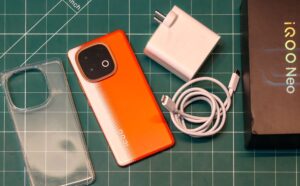Last year, HUAWEI launched NearLink, a new way to transfer data for smartphones. The technology is already integrated into the company’s flagship devices, works many times faster than Bluetooth, and may soon become an industry standard. Let’s remember how data was exchanged using phones before — and what it looks like now.
IR Blaster
Raise your hand to someone who has put one phone on another to pass an mp3 file with a title like “!! SuPeR@megahit_2003!!!». You have used the infrared method of data transmission. The technology became widespread in the 90s, and in terms of the principle of operation, it resembled TV remote controls: an infrared LED transmits information, and a photodiode receives it.
In phones of the 2000s, the data transfer speed rarely exceeded 10 kbps, so it took a whole break to send a small video. And the process was immediately interrupted if there was an obstacle in front of the signal, so the phones could not be touched.
By the way, it is possible that your smartphone now has an infrared port – this is the same black rivet at the top or bottom of the device. Thanks to it, you can use your smartphone as a universal remote.

An example of a modern flagship smartphone with an infrared port is the HUAWEI Pura 70 Ultra
Bluetooth
In the mid-noughties, Bluetooth transmission could surprise classmates and fellow students who were not well-versed in technology — how is it that files are simply sent through the air across the room?
Bluetooth came into existence in the late 1990s and quickly became the wireless communication standard. The current version allows data to be transmitted over distances of up to 150 meters with a theoretical speed of up to 50 Mbit/s, although in reality it barely exceeds 2 Mbit/s.
Today, individual files are rarely transmitted via Bluetooth – the standard is used to connect peripherals, transmit audio and streaming data.
NFC
Unlike the mentioned standards, NFC came in handy as an emulator of a contactless card – 5-6 years ago, the presence of this chip was a decisive factor when choosing a budget smartphone.
The standard operates at frequencies of 13.56 MHz, so its range is low – about 10 centimeters. But the NFC chip is inexpensive and can be placed even under a sticker, which is one of the reasons why the technology spread so quickly around the world.
HUAWEI Share allows you to link your laptop and smartphone with a single touch. Now, most laptops have NFC integrated, but they used to hide it behind a sticker — like in this 2020 MateBook D14
And unlike Bluetooth, the NFC connection is instantaneous, so you don’t have to wait half a minute when you bring your smartphone to the payment terminal.
NearLink
The development of HUAWEI is designed to replace Bluetooth, which for 20 years of development has not gotten rid of numerous “crutches”. The new standard uses the same frequency range as Bluetooth (2.4 GHz), but according to the company’s employees, it has a number of advantages:
- File transfers are six times faster.
- 30 times less delay;
- 60% lower energy consumption;
- Up to 50 devices can be connected at the same time;
- twice the coverage area.
NearLink is already integrated into HarmonyOS and is found on more and more devices – from the Pura 70 Pro to the MatePad Pro and MateBook X Pro 2024.
To enable NearLink on your smartphone, just find the corresponding tab in the settings
Thanks to a large number of possible connections, NearLink is able to connect many types of appliances – from smart home to accessories and even cars. It is this technology that can make HarmonyOS not just an operating system for smartphones, but a full-fledged hub that will control the electronics around you.
That’s how we’ve evolved over the past 25 years, from wireless image transmission to standards that can link together dozens of devices and send tons of information every second.
















